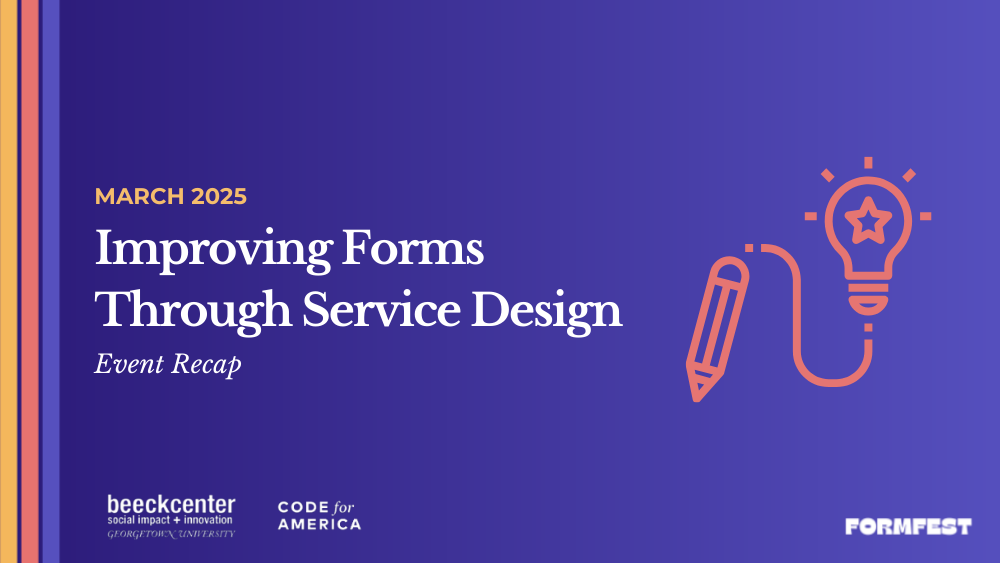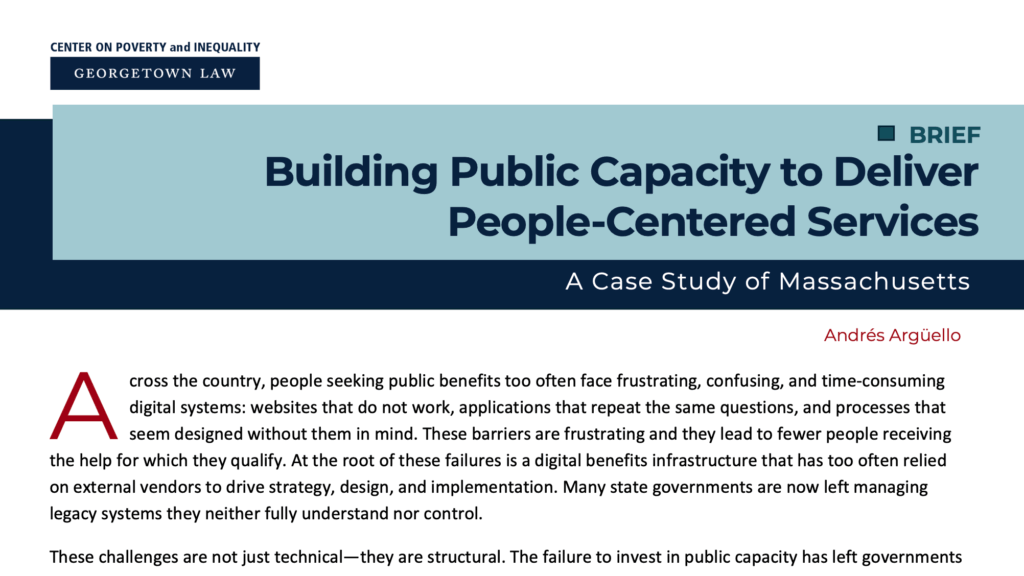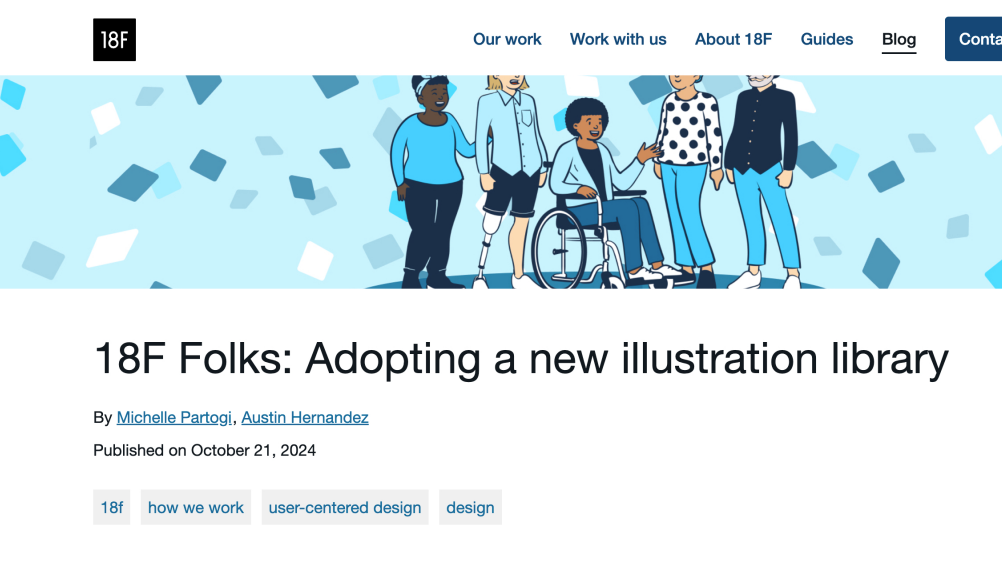FormFest 2024 Recap: Improving Forms Through Service Design
An event recap from one of FormFest 2024’s breakout sessions featuring speakers from Digital Service Teams across the United States and the U.S. Department of Veteran Affairs.

These sessions from FormFest 2024 explore how governments can improve service delivery by improving service design. First, learn from Boston’s experiences shifting to end-to-end digital service delivery with insights from digital service teams in Austin, San Francisco, and Philadelphia. Then, take a deep dive into the Department of Veteran Affairs’ (VA) project to apply service design principles to form revisions.
Beyond Forms: Digital Service Delivery

Over the last two years, the City of Boston, Massachusetts has been on a digital service transformation journey after the pandemic expedited the rapid digitalization of paper-based processes for critical city systems. In the wake of these shifts, Boston partnered with the Service Design Collective to ask how other cities were transforming their city’s digital service delivery. It was through this partnership to learn more about the work their digital service teams were doing that Julia Gutiérrez, the chief digital officer for the City of Boston, connected with Lucy Burns (City and County of San Francisco, California), Anthony Yandura (City and County of Philadelphia, Pennsylvania), and Mark Janchar (City of Austin, Texas). In this presentation, Julia led a group discussion centered on the tips and tricks these presenters learned while helping manage a total of over 2,400 city services.
Gutiérrez opened the discussion by asking how the Philadelphia and Austin teams were working to move the needle from service design to building forms. Janchar discussed his team’s work redesigning the service hub for the website AustinTexas.gov, emphasizing the reorganization of services into more manageable categories on the site. Yandura then shared how his team was working to expand resources to help partners move beyond data and focus on process improvement and sustainable change.
Next, Burns shared how her team has been working to efficiently scale good service delivery. She noted that they developed a five-part technology-agnostic training series on service delivery, aiming to shift their model from merely building solutions for partners to advising them on developing their own processes. From this work, she learned that partners valued the ability to see the big picture with a service blueprint and use it to communicate with their team members.
Lastly, the panelists discussed the challenges and opportunities they faced in their work. They noted that one challenge of digitizing service delivery is that their teams are not in charge of the services themselves, which can make influencing good service delivery difficult. However, one way to address this challenge is by funneling partners into better design practices, Yandura shared. For example, he mentioned that partners seeking to use Philadelphia’s website are required to conform to standards set by his team. More importantly, however, he mentioned that treating everything as an engagement or partnership and meeting service providers where they are can help ease this challenge. He recommends building trust with partners by valuing their input and recognizing their expertise. Janchar additionally jumped in during this discussion to share that his team found training and workshops to be a valuable way to connect with partners and spread the word about the work his team was doing. Overall, this session helped participants learn tips and tricks to remember when responding to rapid digitalization or transitioning to end-to-end service delivery.
Service Design Principles for Improving Forms Experiences

This session was presented by the consumer experience catalog team from the Department of Veterans Affairs (VA). The team, composed of Amanda Krauss, Natassia Chowthi, Oliver Goodman, and Courney Stubbert, recently worked to improve the benefits claims experience at VA using service design. When they approached this project, they quickly learned that forms are just one part of a complex claims ecosystem. Therefore, it was important to create a map of actors, system processes, and relationships to assemble a comprehensive view of how the benefits claim process worked and identify the root causes behind denials and delays.
Walking participants through their work as a case study, the team explained that they needed to go deeper than the form itself to understand the ecosystem, actors, and backstage processes to properly tackle the project. Chowthi stated that one helpful method for understanding the backstage of a process is service blueprinting. Service blueprinting is a visual mapping technique that can create alignment on how processes work, reveal pain points in the user experience, and also help identify the root causes of these pain points. Using this method, the team identified data gaps causing errors and delayed payments, which had been erroneously attributed to poor claims processing, even though it resulted from a lack of user data. As a whole, the team found this process important for figuring out how they could solve the problem by forming relationships with other parts of the user experience—allowing them to move beyond simple form improvements.
To wrap up the presentation, Stubbert shared some guiding principles with attendees to apply in their own service design work:
- Always design for the needs of people: Determine who will be using the form and which actors will be impacted by changes.
- Co-design the complete customer experience: Identify ways to partner with other stakeholders and collaborate with those working in other silos to help break them down.
- Understand the present to improve the future: To address current pain points, develop a vision of what is currently happening within the system and envision the desired future outcome of the service.
- Return to the data to reveal the right problems to solve: Examine data to identify where users are struggling. Use data to anchor feedback and inform your improvement process.
By applying these principles, the team created a first-of-its-kind, holistic, end-to-end view of the benefits experience, uncovering key root causes behind denials and delays. In the future, this work will make it possible for veterans, VA staff, and VA product leadership to more easily navigate the claims process.
Key Takeaways
- Collaboration is powerful. Leaning on and learning from other governments was what made the Boston Digital Service team’s work successful. It is critical to break down silos and develop communication pathways not only between actors in the service delivery process, but also beyond it. Workshops, trainings, and ecosystem mapping can be powerful tools for creating opportunities for collaboration.
- Forms are just the tip of the iceberg. Forms are not standalone items, but exist in a web of actors, policies, and product flows. Given that changes in one part of this system will affect many other parts, it is important to develop a more holistic view of service delivery that goes below the surface.
- Context is key. Contextualizing the work a form is doing can help speed the work of decision-makers, product managers, and strategists, as they try to improve service delivery. Using data can make this contextualization concrete and easily digestible to stakeholders. Describing the context and anchoring it in data can also help digital service teams identify pain points and ensure that improvements are user-centered.
See more from this session at FormFest 2024:
Watch the session recording and more from FormFest 2024.
Improving Digital Service Design
This session from FormFest 2024 focused on improving service delivery by hearing about work in multiple cities to rapidly digitize service delivery and work by the Department of Veteran Affairs around implementing service design principles in form revisions.
About FormFest
FormFest is a free virtual event showcasing governments working to make services accessible to everyone through online forms. Discover best practices and tools that are shaping the future of form design and service delivery.


